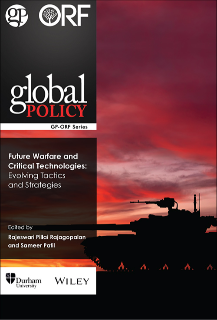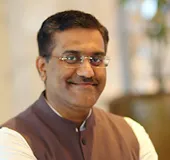Introduction
Modern warfare has continuously evolved, with technological advancements shaping its conduct. Critical technologies like cyberspace and artificial intelligence (AI) are making new warfighting tools available, even as traditional ones like nuclear weapons are witnessing a resurgence. These changes have brought greater lethality and destruction in warfighting and blurred the lines of conflict, with direct warfare being replaced by new forms such as hybrid warfare or grey zone tactics (where the threat has diffused, and proxy actors have taken the lead).
Multiple analytical frameworks have examined this shift in warfare, studying its implications for tactics and strategies. For example, the ‘generations of warfare’ literature describes five generations of warfare. First-generation warfare involved person-to-person fighting, primarily dependent upon physical strength, skills, and numbers. Second-generation warfare, through firepower, resulted in combatants with asymmetrical force or strength levels being able to impose their will on traditionally more powerful adversaries. Third-generation warfare prioritised manoeuvres after infiltrating enemy lines. Fourth-generation warfare blurred boundaries between state and non-state actors and border regions and the hinterland, with terrorism or proxy warfare holding primacy. The decision-making process of the target’s leadership is targeted in this form of warfare. Fifth-generation warfare aims to control the adversary’s population by distorting their worldview and threat perceptions, even without knowledge of the target.
These shifting battlefields have transformed with critical technologies like cyber, virtual, and augmented reality (VR/AR), AI, and 3D printing. Several of these technologies have made the battlefield a complex and interconnected ecosystem with the convergence of the physical and virtual domains. They have allowed combatants to engage in fighting without resorting to kinetic means, which has been the hallmark of the battles of the previous centuries. At the same time, they have also spawned discussions about their ethical implications, legal frameworks, and potential unintended consequences. The use of lethal autonomous weapon systems, for instance, has been a controversial topic, with a growing chorus of voices from various sectors advocating for a global prohibition for their purported violation of international humanitarian law. Similarly, using cyber tools to target critical national infrastructure has raised concerns about potential widespread disruption and civilian casualties, which may have cascading effects on other essential infrastructure and services. Yet, several countries are pursuing these technologies to weaponise and deploy them as quickly as possible.
National security establishments and military planners worldwide are now faced with new challenges with this transformation in warfighting. It has made policy choices more complex and responses more challenging. The essays in this volume seek to unpack key critical technologies and explore their implications for the future of warfare. They tackle themes like cyberwarfare, challenges of attribution, swarming drones, autonomous weapons, AI, and their impact on land warfare, blockchain, and warfighting while also looking at the impact of these technological advancements on nuclear weapons and space. These essays, written by domain experts and renowned scholars, answer four critical questions: Who/what are we fighting? Where are we fighting? How are we fighting? And when are we fighting?
Zachary Kallenborn, discussing the drone swarms, argues that while their global proliferation is expected, it will not happen immediately. Different states will adopt different approaches to their proliferation—some focusing on numbers, some focusing on the drones’ technological sophistication, and others implementing export controls to check their spread. Exploring another critical technology, Akshat Upadhyay examines the role of VR/AR in warfare. He highlights that VR and AR have increased relevance for warfighting, as VR can stimulate conditions that are impossible to create in the lab or on training grounds for safety reasons, while AR adds a layer of additional information (audio, visual, haptic), heightening the sensory performances required for the battlefield.
Looking at cyber warfare, Nishant Rajeev discusses how states exploit cyberspace to further their strategic objectives. He argues that it is easier for states to leverage cyber capabilities in the competitive dynamic than in the armed conflict or wartime dynamic due to the unique nature of cyber capabilities. Next, Meghna Bal and Mohit Chawdhry, discussing the utility of blockchain technology for warfighting, look at the prominent early-use cases and argue that while several militaries are experimenting with the technology, its utility in military operations is presently unproven. Meanwhile, Shruti Sharma focuses on biotechnology and highlights its crucial role in developing and producing biological weapons. Given the dangerous potential of biological agents, she argues that it is necessary to strengthen the norm that biotechnology will be used only in non-harmful ways.
Among other critical technologies, Amoha Basrur looks at generative AI, exploring its utility for militaries and the potential risks involved. Just like biotechnology, she also advocates for the safe and ethical deployment of generative AI. Victoria Samson, examining the role of space and counter-space technologies, highlights the increased importance of space for many countries. This has led to efforts to disrupt other countries’ abilities to utilise space, resulting in the proliferation of counterspace capabilities beyond the major powers.
After looking at the strategic and tactical perspectives on critical technologies, the next set of essays offers general strategic perspectives.
Arindrajit Basu tackles the question of attribution for cyber incidents and notes that India has not publicly attributed a specific international cyber incident to a specific private perpetrator or nation-state. However, as the frequency and intensity of such cyber incidents increase, India cannot afford not to use the critical option of public attribution, when deemed effective, to navigate the uncertainty of cyber unpeace and further its strategic interests. Next, Brian G. Chow looks at the American space warfare capabilities and argues that, although the US has beefed up its capabilities, its overall space resilience is only as strong as its weakest link, particularly when it comes to China, which poses significant threats.
Regarding China, Rajeswari Pillai Rajagopalan discusses the nuclear modernisation of the People’s Liberation Army. She argues that China appears to be undertaking a vast nuclear expansion in quantitative and qualitative terms. While much of this modernisation is aimed at the US, it also has ripple effects among its neighbours in the Indo-Pacific. Tanvi Kulkarni, dwelling further on this theme, examines the role of nuclear deterrence. She argues that two factors—the strength of nuclear norms and the applications of modern and emerging technologies—are most likely to affect how and to what extent nuclear weapons will play a role in future conflicts. Added to this is the uncertainty of global geopolitics and the uncertainty arising from the rapidly evolving nature of existential threats to human life and the environment.
The final two essays explore the related aspects of AI. Michael Depp argues that while significant advancements in AI technology in military systems have occurred, automating ground warfare has proven particularly difficult. Much of the progress has been achieved in air and naval systems. Nonetheless, these advancements will be the key to effectively using AI for success in ground operations. Finally, Laura Bruun argues that as more and more militaries become dependent on AI, it may add new layers to the fog of warfare. Therefore, developing a deeper understanding of the risks is critical to ensure legal compliance and human accountability in future and potentially more AI-reliant warfare. In a sense, this is a precautionary tale for applying all critical technologies in warfighting.
Overall, this compendium of 13 essays brings out multiple nuances of the implications of critical technologies for warfighting.
We want to thank our editor, Preeti Lourdes John, for her immaculate editing and efforts to make the volume publication-ready.
Rajeswari Pillai Rajagopalan and Sameer Patil
The views expressed above belong to the author(s). ORF research and analyses now available on Telegram! Click here to access our curated content — blogs, longforms and interviews.

 PDF Download
PDF Download



 PREV
PREV



